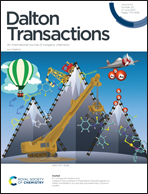2-Hydroxyphenyl benzimidazoles and their boron complexes: synthesis, structure, aggregation-induced emission and picric acid sensing†
Abstract
A series of differently substituted 2-(2-hydroxyphenyl) benzimidazoles were synthesized by a coupling reaction involving aryl dibromides and 2-hydroxyphenyl benzimidazole. These ligands react with BF3·Et2O to yield the corresponding boron complexes. The photophysical properties of the ligands (L1–L6) and the boron complexes (1–6) were studied in the solution state. Among these, the ligands L1–L4 and L6 displayed aggregation-induced emission (AIE) behavior upon the addition of water in THF resulting in a sizable enhancement of fluorescence intensity. Additionally, compound 5 was found to detect picric acid with a detection limit of 8.33 × 10−7 M.



 Please wait while we load your content...
Please wait while we load your content...